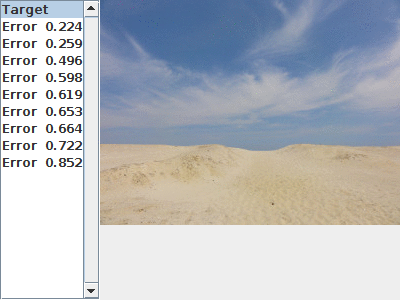Example Color Histogram Lookup
From BoofCV
Jump to navigationJump to searchImage color histograms can be treated as features. These features can then be used to look up similar images. The example below shows how different color spaces can be used to look up similar images from a data set of vacation photos. The animated image above show the results from a query.
Example Code:
Concepts:
- Scene Classification
- Dense Image Features
- Clustering
- k-NN classifier
Example Code
/**
* Demonstration of how to find similar images using color histograms. Image color histograms here are treated as
* features and extracted using a more flexible algorithm than when they are used for image processing. It's
* more flexible in that the bin size can be varied and n-dimensions are supported.
*
* In this example, histograms for about 150 images are generated. A target image is selected and the 10 most
* similar images, according to Euclidean distance of the histograms, are found. This illustrates several concepts;
* 1) How to construct a histogram in 1D, 2D, 3D, ..etc, 2) Histograms are just feature descriptors.
* 3) Advantages of different color spaces.
*
* Euclidean distance is used here since that's what the nearest-neighbor search uses. It's possible to compare
* two histograms using any of the distance metrics in DescriptorDistance too.
*
* @author Peter Abeles
*/
public class ExampleColorHistogramLookup {
/**
* HSV stores color information in Hue and Saturation while intensity is in Value. This computes a 2D histogram
* from hue and saturation only, which makes it lighting independent.
*/
public static List<double[]> coupledHueSat( List<File> images ) {
List<double[]> points = new ArrayList<double[]>();
Planar<GrayF32> rgb = new Planar<GrayF32>(GrayF32.class,1,1,3);
Planar<GrayF32> hsv = new Planar<GrayF32>(GrayF32.class,1,1,3);
for( File f : images ) {
BufferedImage buffered = UtilImageIO.loadImage(f.getPath());
if( buffered == null ) throw new RuntimeException("Can't load image!");
rgb.reshape(buffered.getWidth(), buffered.getHeight());
hsv.reshape(buffered.getWidth(), buffered.getHeight());
ConvertBufferedImage.convertFrom(buffered, rgb, true);
ColorHsv.rgbToHsv_F32(rgb, hsv);
Planar<GrayF32> hs = hsv.partialSpectrum(0,1);
// The number of bins is an important parameter. Try adjusting it
Histogram_F64 histogram = new Histogram_F64(12,12);
histogram.setRange(0, 0, 2.0*Math.PI); // range of hue is from 0 to 2PI
histogram.setRange(1, 0, 1.0); // range of saturation is from 0 to 1
// Compute the histogram
GHistogramFeatureOps.histogram(hs,histogram);
UtilFeature.normalizeL2(histogram); // normalize so that image size doesn't matter
points.add(histogram.value);
}
return points;
}
/**
* Computes two independent 1D histograms from hue and saturation. Less affects by sparsity, but can produce
* worse results since the basic assumption that hue and saturation are decoupled is most of the time false.
*/
public static List<double[]> independentHueSat( List<File> images ) {
List<double[]> points = new ArrayList<double[]>();
// The number of bins is an important parameter. Try adjusting it
TupleDesc_F64 histogramHue = new TupleDesc_F64(30);
TupleDesc_F64 histogramValue = new TupleDesc_F64(30);
List<TupleDesc_F64> histogramList = new ArrayList<TupleDesc_F64>();
histogramList.add(histogramHue); histogramList.add(histogramValue);
Planar<GrayF32> rgb = new Planar<GrayF32>(GrayF32.class,1,1,3);
Planar<GrayF32> hsv = new Planar<GrayF32>(GrayF32.class,1,1,3);
for( File f : images ) {
BufferedImage buffered = UtilImageIO.loadImage(f.getPath());
if( buffered == null ) throw new RuntimeException("Can't load image!");
rgb.reshape(buffered.getWidth(), buffered.getHeight());
hsv.reshape(buffered.getWidth(), buffered.getHeight());
ConvertBufferedImage.convertFrom(buffered, rgb, true);
ColorHsv.rgbToHsv_F32(rgb, hsv);
GHistogramFeatureOps.histogram(hsv.getBand(0), 0, 2*Math.PI,histogramHue);
GHistogramFeatureOps.histogram(hsv.getBand(1), 0, 1, histogramValue);
// need to combine them into a single descriptor for processing later on
TupleDesc_F64 imageHist = UtilFeature.combine(histogramList,null);
UtilFeature.normalizeL2(imageHist); // normalize so that image size doesn't matter
points.add(imageHist.value);
}
return points;
}
/**
* Constructs a 3D histogram using RGB. RGB is a popular color space, but the resulting histogram will
* depend on lighting conditions and might not produce the accurate results.
*/
public static List<double[]> coupledRGB( List<File> images ) {
List<double[]> points = new ArrayList<double[]>();
Planar<GrayF32> rgb = new Planar<GrayF32>(GrayF32.class,1,1,3);
for( File f : images ) {
BufferedImage buffered = UtilImageIO.loadImage(f.getPath());
if( buffered == null ) throw new RuntimeException("Can't load image!");
rgb.reshape(buffered.getWidth(), buffered.getHeight());
ConvertBufferedImage.convertFrom(buffered, rgb, true);
// The number of bins is an important parameter. Try adjusting it
Histogram_F64 histogram = new Histogram_F64(10,10,10);
histogram.setRange(0, 0, 255);
histogram.setRange(1, 0, 255);
histogram.setRange(2, 0, 255);
GHistogramFeatureOps.histogram(rgb,histogram);
UtilFeature.normalizeL2(histogram); // normalize so that image size doesn't matter
points.add(histogram.value);
}
return points;
}
/**
* Computes a histogram from the gray scale intensity image alone. Probably the least effective at looking up
* similar images.
*/
public static List<double[]> histogramGray( List<File> images ) {
List<double[]> points = new ArrayList<double[]>();
GrayU8 gray = new GrayU8(1,1);
for( File f : images ) {
BufferedImage buffered = UtilImageIO.loadImage(f.getPath());
if( buffered == null ) throw new RuntimeException("Can't load image!");
gray.reshape(buffered.getWidth(), buffered.getHeight());
ConvertBufferedImage.convertFrom(buffered, gray, true);
TupleDesc_F64 imageHist = new TupleDesc_F64(150);
HistogramFeatureOps.histogram(gray, 255, imageHist);
UtilFeature.normalizeL2(imageHist); // normalize so that image size doesn't matter
points.add(imageHist.value);
}
return points;
}
public static void main(String[] args) {
String regex = UtilIO.pathExample("recognition/vacation")+"/^\\w*.jpg";
List<File> images = Arrays.asList(BoofMiscOps.findMatches(regex));
Collections.sort(images);
// Different color spaces you can try
List<double[]> points = coupledHueSat(images);
// List<double[]> points = independentHueSat(images);
// List<double[]> points = coupledRGB(images);
// List<double[]> points = histogramGray(images);
// A few suggested image you can try searching for
int target = 0;
// int target = 28;
// int target = 38;
// int target = 46;
// int target = 65;
// int target = 77;
double[] targetPoint = points.get(target);
// Use a generic NN search algorithm. This uses Euclidean distance as a distance metric.
NearestNeighbor<File> nn = FactoryNearestNeighbor.exhaustive();
FastQueue<NnData<File>> results = new FastQueue(NnData.class,true);
nn.init(targetPoint.length);
nn.setPoints(points, images);
nn.findNearest(targetPoint, -1, 10, results);
ListDisplayPanel gui = new ListDisplayPanel();
// Add the target which the other images are being matched against
gui.addImage(UtilImageIO.loadImage(images.get(target).getPath()), "Target", ScaleOptions.ALL);
// The results will be the 10 best matches, but their order can be arbitrary. For display purposes
// it's better to do it from best fit to worst fit
Collections.sort(results.toList(), new Comparator<NnData>() {
@Override
public int compare(NnData o1, NnData o2) {
if( o1.distance < o2.distance)
return -1;
else if( o1.distance > o2.distance )
return 1;
else
return 0;
}
});
// Add images to GUI -- first match is always the target image, so skip it
for (int i = 1; i < results.size; i++) {
File file = results.get(i).data;
double error = results.get(i).distance;
BufferedImage image = UtilImageIO.loadImage(file.getPath());
gui.addImage(image, String.format("Error %6.3f", error), ScaleOptions.ALL);
}
ShowImages.showWindow(gui,"Similar Images",true);
}
}
